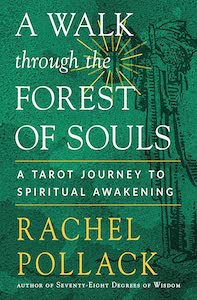
A Walk Through the Forest of Souls: A Tarot Journey to Spiritual Awakening, by Rachel Pollack
Weiser Books, 1578637708, 288 pages, May 2023
Award-winning science fiction author, comic book writer, tarot expert, and trans activist Rachel Grace Pollack passed away on April 7th, 2023, at the age of 77. Born Richard A. Pollack on August 17th, 1945, in Brooklyn, New York, Rachel came out as a transgender woman in 1971, at the age of 26. During this time, Pollack discovered tarot and broke into publishing with a science fiction short story titled “Pandora’s Bust,” which appeared in New Worlds Quarterly.1
Pollack had an impressive literary career, publishing four short story collections and seven novels, three of which received awards. Unquenchable Fire won the Arthur C. Clarke Award in 1989, Temporary Agency (1994) won the Nebula Award, and Godmother Night (1996) won the World Fantasy Award. Pollack also blazed a trail through the DC Universe by creating Coagula, aka Kate Godwin, the first transgender superhero, while writing issues 64-87 of the rebooted DC Comics series Doom Patrol (1993-1995). However, it was the classic tarot tome Seventy-Eight Degrees of Wisdom (1980) that was the most influential work in Pollack’s oeuvre, and established Pollack as a leading authority on tarot.2
A Walk through the Forest of Souls: A Tarot Journey of Spiritual Awakening is a revised version of the out of print book titled The Forest of Souls: A Walk through the Tarot, first published in 2002. In this updated work, Pollack’s approach to reading the cards is innovative, intuitive, and imaginative. Rather than a cookbook of interpretive meanings, A Walk Through the Forest of Souls is a guide to using the tarot as a spiritual tool to expand consciousness and open one’s mind to new possibilities.
“This book contains some outrageous ideas and questions,” Pollack says. “We will play with the idea that the Tarot images existed before the creation of the universe, that God somehow consulted the cards to make the world, and even that we can use the cards to find the very reading that God received.”3
Pollack is Jewish, but mischievously identifies as a heretic. The idea of God making a card game of creation is not meant to be taken as literal truth, but to be regarded as serious play. “God in these pages becomes a way to express our universal desire to know and comprehend the sacred,” says Pollack.4
Unlike an ordinary book, “the pages of the Tarot are not bound in any real order.”5 Through the act of shuffling, a new deck is created, and we are given the opportunity to turn over a new leaf, so to speak.
“In this book readings do not reveal a fixed future,” Pollack says. “They become a means to gain new perspectives and explore possibilities outside our normal ways of thought.”6
Pollack’s science fiction background shines through this book’s non-linear approach to the concept of time. “The future can ‘cause’ the past as much as the past causes the future,” Pollack says. “In fact, neither one causes the other, they exist in a relationship that goes in many directions at once. Imagine a web with a vast number of points, all connected to each other, with no single point as the origin or primary cause of the others. Our consciousness places us in one point, convincing us that a single line from the past has caused our current situation to come into being. But this may be an illusion.”7
Tarot reveals possibilities, not an immutable fate, and Pollack even goes so far as to say that since “divination creates new possibilities, it liberates the Creator from a universe where everything is planned and known ahead of time.”8
I recently rewatched the original Star Trek movies, and Pollack’s concept of nonlinear time being an elastic web in which the future can influence the past brings to mind a particular scene in Star Trek IV: The Voyage Home (1986). In this film, Admiral Kirk and his crew time travel to late 20th century San Francisco on a mission to bring two humpback whales back to the future in order to repopulate a 23rd century Earth where they are extinct.
Chief engineer Montgomery Scott and Dr. “Bones” McCoy visit a Plexiglas factory seeking construction materials for a whale tank. In exchange for the glass, Scotty gives the proprietor Dr. Nichols the formula for transparent aluminum, a futuristic construction material that is lighter and stronger than the Plexiglas he is currently manufacturing.
“You uh, realize of course if we give him the formula, we’re altering the future,” Bones says. “Why, how do we know he didn’t invent the thing?” says Scotty. His response implies that their need for Plexiglas is part of a predestination paradox, or causal loop, in which the invention of transparent aluminum depends on the necessity of their time travel in the first place.9
I’m a fan of non-linear thinking, and it’s mind-blowing to apply the predestination paradox to tarot reading. Perhaps the guidance we receive from the cards comes from our future selves, who, like Scotty, plant ideas in our minds that may not otherwise have come to us10
Pollack suggests using the cards for “Wisdom readings,”11 which transcend personal concerns by seeking deeper meaning with universal questions like “What is the soul?”12 According to Pollack, the tarot is an instrument we can use to communicate directly with Sophia, the divine personification of wisdom, and we limit its vast potential when we only focus on personal questions.13
The title of this book, A Walk through the Forest of Souls, was inspired by Pollack’s first Wisdom readings, using the Shining Tribe Tarot, a deck created by Pollack. When Pollack asked, “What is the soul?” the Ace of Birds (Ace of Swords) appeared, depicting an owl, the animal familiar of Athena, the Greek goddess of wisdom.14
Pollack then asked the cards, “What is Tarot?”15 The answer was the Six of Trees (Six of Wands), which depicts trees with owl eyes. “If the soul is an owl,” Pollack says, “then these woods become a forest of souls, and the Tarot, as the title of this book says, is ‘a walk through the forest of souls.’”16
In my own readings, I have found that lately, I tend to ask fewer personal questions and more cosmic ones, such as, “What will be the influence of the Full Moon in Cancer?” or some other upcoming astrological transit. Inspired by Pollack’s “Wisdom reading” method, I decided to ask questions about the symbolic language of mythology.
The first question that entered my mind was: “Why does the goddess Demeter carry two torches when searching for her daughter Persephone, when one would provide sufficient light and a free hand?” I knew that the twin torches symbolized some sort of celestial light, perhaps the horns of the night-wandering moon, but I wondered specifically why there were two of them. The answer I received surprised me, yet made so much sense.
I drew three cards from the Crow Tarot: The Star, The Empress, and the Four of Wands. Venus, as the Morning and Evening Star, immediately came to mind. In her dual forms as herald of dawn and dusk, she represents two lights, or two heavenly torches. The astrological association for The Empress is the planet Venus, and the Four of Wands is associated with Venus in Aries.
Reading the cards like a sentence, I was moved by the heartwarming message I received: She is the Mother Star (Empress + Star), guiding her children back home (the Four of Wands represents the home and is a card of celebration, and the astrological association of Venus in Aries reminds me of Demeter and Persephone’s springtime reunion).
In retrospect, I used to be confused by The Empress being associated with both Venus, the goddess of love, and Demeter, the goddess of the harvest. I didn’t think of Demeter as being Venusian, since she is so often depicted as wandering in grief, searching for her lost daughter. After contemplating these cards, I now link Venus, the Heavenly Mother, and Demeter, the Earthly Mother, in the following way: When we are born, we descend into matter, like Inanna, the Sumerian Venus, descending into the Underworld.
When we get lost in the trappings of materialism, we can lose touch with our divine mother, and without her guidance, we may feel as though we are wandering alone in the dark. But she also descends with us, as chthonic Demeter, an earthly manifestation of Venusian energy. When we realize that the Goddess is simultaneously here with us on earth, as well as in heaven, we are reunited with her, just as Venus, the Morning Star, (or in the case of Demeter, a star of mourning) is reborn and emerges from the Underworld, and Persephone is reunited with Demeter. When we see and feel the presence of the Earth Mother made manifest in the physical realm, we are blessed by her with fertility, wealth, and abundance. When we are depressed and feel separated from her, the world in turn feels cold and barren.
The leaves of tarot whisper to us all in unique ways, and the possibilities for interpretation are limitless. Pollack’s work encourages us to tap into our intuitive creativity and experience the tarot like we never have before. Experimenting with Wisdom readings has shifted my perspective on how to use tarot, and I plan on exploring Pollack’s techniques further in my personal practice.
Beginners may get lost trying to follow Pollack’s twists and turns through the Forest of Souls, but this thought-provoking guide will be a breath of fresh air for intermediate to advanced tarot enthusiasts, opening them up to expansive new ideas regarding what tarot is and how to use it. This final work will no doubt be a classic in Pollack’s enduring tarot legacy.

Rachel Christina McConnell is a witch, tarot reader, intuitive astrologer, and writing spider. She holds an MFA in Fiction from Columbia University in the City of New York. Her short stories have appeared in Dark Moon Lilith Press and Minerva Rising Press’s The Keeping Room. Links to her publications are available here: https://rachelchristinamcconnell.wordpress.com
References
- Sources: Wikipedia: https://en.wikipedia.org/wiki/Rachel_Pollack; Article in the Guardian: https://www.theguardian.com/books/2023/apr/08/rachel-pollack-trans-activist-and-comic-book-writer-dies-aged-77 and article in Them: https://www.them.us/story/rachel-pollack-comic-book-writer-tarot-expert-profile
- About the Author on page 269; https://www.dc.com/blog/2023/03/24/rachel-pollack-s-doom-patrol-is-an-underread-masterpiece
- page 6
- page 7
- page 2
- page 2
- page 19
- page 102
- Transparent Aluminum scene from Star Trek: https://youtu.be/90eg_erObDo
- Wikipedia article on Causal Loops: https://en.wikipedia.org/wiki/Causal_loop
- page 53
- page 49
- page 54
- page 49,51
- 54
- page 54
